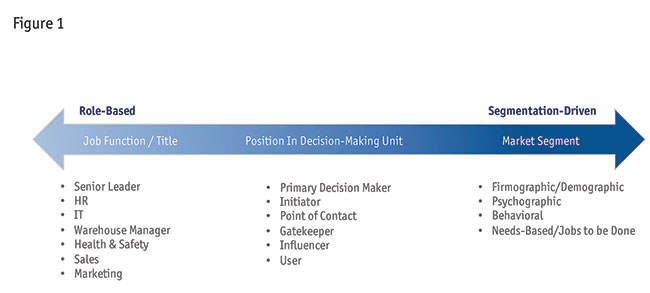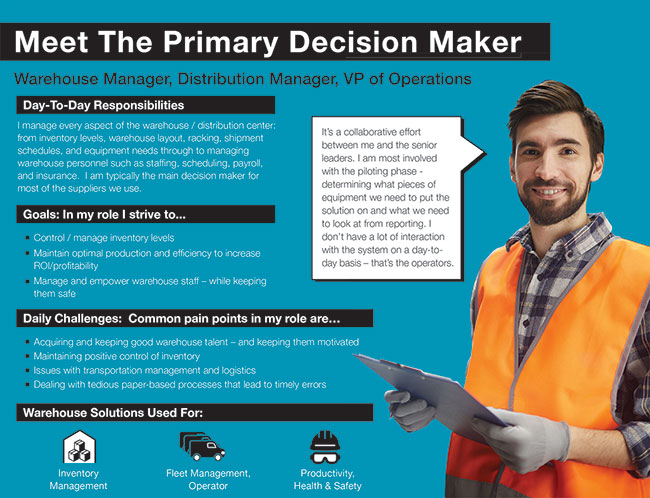Bringing the buyer to life
Editor's note: Daniel Attivissimo is a research director in the New York office of research firm B2B International.
 The world of B2B selling has evolved over the last decade. Digital technologies have blurred the lines across traditional channels and sales strategies and account-based marketing is reframing the way B2B sales organizations approach customer accounts. What’s more, B2B decision makers are bringing their experiences as consumers with them to work and are requiring more of a seamless, omnichannel buying experience. While this shift brings its challenges, it also presents great opportunity for B2B brands to better target and engage different audiences through more tailored offerings around customer needs, attitudes and behaviors. The leading brands of tomorrow will be those that have a laser-focus on the customer and that perfect the customer experience.
The world of B2B selling has evolved over the last decade. Digital technologies have blurred the lines across traditional channels and sales strategies and account-based marketing is reframing the way B2B sales organizations approach customer accounts. What’s more, B2B decision makers are bringing their experiences as consumers with them to work and are requiring more of a seamless, omnichannel buying experience. While this shift brings its challenges, it also presents great opportunity for B2B brands to better target and engage different audiences through more tailored offerings around customer needs, attitudes and behaviors. The leading brands of tomorrow will be those that have a laser-focus on the customer and that perfect the customer experience.
In B2B markets the customer is typically an organization as well as an individual. Companies comprise people and so understanding the individuals within the decision-making unit is just as important as understanding their organization.
Persona profiling humanizes a target audience through identifying the common demographics and characterizing individual needs, buying behaviors, motivations and pain points. Knowing the different personas an organization serves makes it easier for marketing and sales teams to focus resources and better engage with key customer groups.
Buyer personas establish a human connection to buyers by portraying who they are (buyer profile) and how they make buying decisions (buyer insights). This paints a picture of a buyer on multiple levels, enabling organizations to understand the likes of: who to target; what the buyer is seeking to accomplish; how buyer goals motivate behavior; how buyers evaluate solutions; what sources of information are used; where the buyer is purchasing; and why buyers choose certain solutions over others.
A buyer persona is…
- an archetype of actual buyers and their buying process/decisions;
- qualitative in nature;
- personable; filled with quotes, anecdotes and stories about goals, challenges and decision making;
- a way to guide meaningful engagements with customers/prospects.
A buyer persona is not…
- a customer profile or even a real person (despite using data from real people and customers);
- calculated; filled with charts and graphs about demographics/firmographics (therefore, also not a market segmentation);
- a lead-generating exercise or a silver bullet for sales.
There are five reasons to use buyer personas.
Culture: Persona use helps facilitate a cultural shift within the organization towards a customer-centric mind-set. The very nature of conducting buyer persona interviews brings the voice of the customer to the center of the table. This inspires organizational empathy with customers, where business functions view customers as humans and not just numbers on a sales sheet.
Understanding: Personas provide organizations with a better understanding of customers from the customer’s point of view. They are relatively easy to interpret and share and they provide non-marketing functions a way to easily understand buyers without being inundated by stats-heavy reports.
Visualization: They are a clear picture of the target audience, allowing for more thoughtful consideration into go-to-market tactics. The power of visualizing buyer personas is the ability to trigger mental connections that help bridge the gap between the company and the customer.
Planning: With a clear mental image of the buyer in place, planning activities are much easier and more productive. Ideation workshops with a small but cross-functional team are a useful way to implement buyer personas.
Engagement: A persona can help uncover deeper decision drivers and motivations such as goals, challenges and unmet needs. More importantly, the buyer insights are presented in the customer’s own words, avoiding misuse of company/industry jargon. The result is a more delighted and memorable customer experience, leading to great loyalty, advocacy and the ability to command a premium.
Different approaches
Marketing professionals take different approaches in defining buyer personas. Some of the most common approaches run along a spectrum of role-based personas through to segmentation-driven personas (Figure 1).

The success of the approach depends on what will work best for the organization using the personas and the ease of implementation. That said, focusing on the position within the decision-making unit or a role-based approach to buyer personas makes it easier for sales and marketing teams to identify the target individual compared to segmentation-driven approaches, especially those that are needs-based in nature.
Identifiable and actionable
To build a successful buyer persona, it is essential to speak with actual buyers about actual buying decisions (typically in categories that require some decision making as opposed to more impulsive/low consideration purchases). An effective buyer persona should ultimately comprise a combination of buyer profile criteria and insights on the buyer decision making process. This combination ensures the buyer personas are both identifiable and actionable across the organization.
By way of example, the following structure for arriving at buyer personas has proven successful when applied to numerous B2B markets:
Individual: What are their roles and responsibilities, their years of experience, etc.?
Organization: What is their industry sector, organization size, location, etc.?
Goals: What motivates the individual? And what is their organization trying to accomplish?
Pain points: What keeps them awake at night?
Triggers: What drives a changing need? And what triggers awareness of suppliers/products?
Review: What outlets or methods are used to explore potential suppliers and their offerings?
Purchase-decision drivers: What criteria are evaluated to select the chosen supplier and what are the most important decision drivers?
Engagement: How does the onboarding process unfold?
Relationship: What is the optimal buyer experience? For example, how do they prefer to be communicated with? How frequently, etc.?
Renewal/repurchase: What prompts renewal of a contract or repurchase of the product?
Resonate on an emotional level
B2b organizations utilize buyer personas in a variety of ways but most commonly for sales enablement, marketing and product planning activities. As internal teams familiarize – and ideally immerse – themselves with the buyer personas, the tone of communication will sound more customer-oriented versus company-oriented and therefore resonate on an emotional level for a deeper connection with customer accounts.
Sales enablement/training
Sales engagement/playbook: Personas can guide the language to use when engaging with certain personas and effectively position the brand’s value proposition for its solutions. Buyer personas can also aid in the development of sales tools (Figure 2) such as battle cards, sales guides, etc.

Customer persona identification: They complement segmentation typing tools with a list of probing questions (either to ask or observe) about the company culture, the role of solutions, goals and challenges.
Marketing communications
Guiding messaging platforms: Personas help you tailor marketing campaigns and content-generation (e.g., white papers, Webinars, blogs, Website development, etc.) to unique personas by connecting what the buyer persona wants to hear with what the company wants to say.
Optimizing the customer experience: They help you assess the moments of truth that matter most across the buyer journey – as well as areas that delight – and pain points that may result in defection. By walking in the buyer persona’s shoes, it is easier to identify ways to optimize the path to purchase and beyond.
Media planning: Personas can serve as helpful guidelines for marketing campaigns and media planning, offering insight on what channels to communicate through, what content to send to whom and when they need it.
Product development
Idea generation and solution retooling: Use the personas to think of new ways to address market needs and concerns and/or how existing solutions can be retooled for more effective adoption and utilization.
Product-planning road maps: Guide product lifecycle management by learning from buyer personas to better organize the existing product portfolio and inform future product pipeline initiatives around buyer needs and behaviors.
Creation of value
If the role of marketing can be boiled down into a simple definition, it would arguably be the creation and communication of value between organizations, customers and channel partners. As the world of B2B selling becomes more complex – with disruptive technologies, a more informed buyer and emerging new channels – sometimes the most effective solution is to stick with the basics. Developing buyer personas helps B2B organizations focus on creating and communicating value by painting a clear picture of how buyers seek and evaluate solutions, while bringing the true voice of the customer front and center. Isn’t that what effective marketing is all about?
Quick tips for success with buyer personas
- Achieve internal buy-in by including sales, marketing, product, senior leaders, etc., at the planning stages of the research.
- Conduct interviews with buyers who have recently evaluated and acquired a solution (time period will vary based on sales cycles but anywhere between the last three to six months is ideal).
- Have an experienced interviewer conduct the buyer persona interviews. Ideally, you’d want someone who is impartial to the client relationship, e.g., someone outside of sales.
- After the qualifying questions and a quick warm-up, start the interview with the point in which the organization recognized the need to look into the solution.
- Stay focused: Target personas that have true influence/impact on buying decisions. Use their insights to understand other members on the edge of the decision-making unit.
- Make sure to align the persona with their respective buyer journey. This will help drive more effective marketing and product planning strategies.
